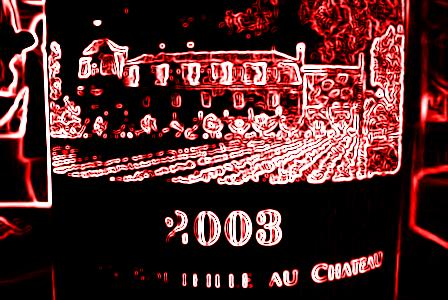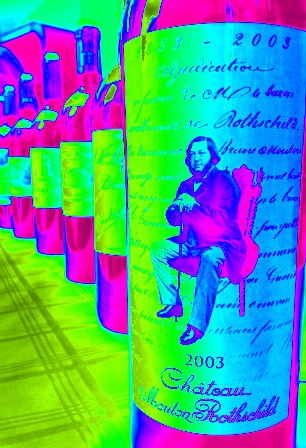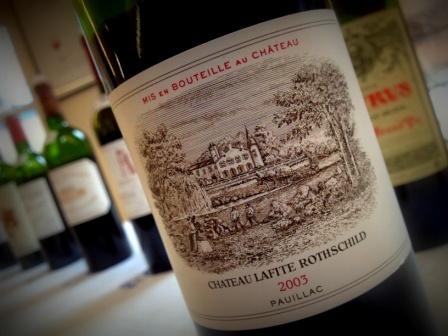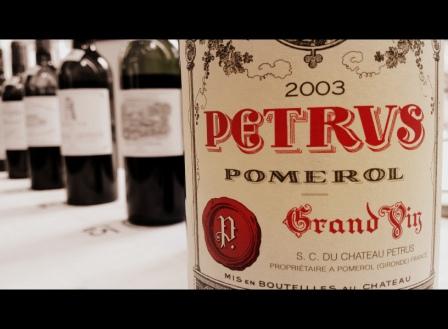Bordeaux 2003
(by peter, tasting with susie)
 I’m out to Bordeaux for the en primeur tastings of the still embryonic 2012 vintage soon. (I’m thinking of releasing a report called ‘non-primeurs’ afterwards, but let’s not stir the pot too much just yet.)
I’m out to Bordeaux for the en primeur tastings of the still embryonic 2012 vintage soon. (I’m thinking of releasing a report called ‘non-primeurs’ afterwards, but let’s not stir the pot too much just yet.)
By way of send-off, the nice people at Bordeaux Index were running their annual 10-year-on claret line-up – and this year it was the turn of 2003 – funnily enough, the first en primeur tastings I attended in Bordeaux.
Rather than go on at length about the vintage and tasting, I thought it might be easier to distil the key points into bite-size chunks.
So here goes. Both Susie and I tasted the wines, which included all the big names, and the results below reflect both our marks. Wines are listed in descending order of preference (or ranking).
Prices given are approximate, for cases, in bond. Contact Bordeaux Index if you’re interested in buying.
 2003: a snapshot of the vintage
2003: a snapshot of the vintage
- The ‘deckchair’ vintage: very hot, dry year gave variable results
- Generally the style is one of firm chewy tannin, slightly baked aromas, lowish acidity and some heat on the finish
- The best wines are those that have managed to retain some harmony and grace (eg Lafite) to soften that sinewy style
2003: the verdict
- This is not a top quality vintage. The wines tend to be hard-going and lack the scent and grace of great claret. It’s not just a case of low-acid, ripe-fruit wines; these are often very chewy and ‘thick’.
- As a result, the pricier wines look over-valued. Better to steer clear and instead look to the beautifully drinking (and under-rated) 2004, while 2000 and 2005 are more complete.
- Even the cheaper wines (the cheapest we feature is still north of £30 per bottle) don’t look great value.
- That said, there are some good 2003s, which will yet benefit from further age in bottle (or, even better, in magnums).
- At the time of the primeurs back in 2004, St Estephe was rated highly, particularly Montrose. I didn’t think it had fared that well since.
- In short, if you really do want to buy into 2003, choose carefully. Put more stock by producer than commune in this heterogeneous vintage.
Top 5 wines
 Lafite Rothschild 2003, 12.5% (£8,300) – where others are burly, this just sings in a gentle, insistent way. Unfurls in silky, scented waves. The wine of the tasting.
Lafite Rothschild 2003, 12.5% (£8,300) – where others are burly, this just sings in a gentle, insistent way. Unfurls in silky, scented waves. The wine of the tasting.- Latour 2003, 13% (£7,850) – surly initially but opens up in muscular yet silken fashion.
- Margaux 2003, 13% (£4,975) – classic perfume, lovely layers and savoury finesse; it’s a tiny bit loose on the finish but still beautiful stuff.
- Mouton-Rothschild 2003, 13% (£3,575) – deftly made, generous and aromatically engaging; while slightly hot on the finish, has good density and grip, lots here to be getting on with.
- Les Forts de Latour 2003, 13% (£1,750) – a slight surprise but Latour’s second wine put in a remarkable performance. Toasty, dense, lots of substance, fabulous stuff.
Top 5 wines outside the first growths
- Smith Haut Lafitte 2003, 13% (£500) – we both loved the rustic, meaty style of this juicy, edgy, compelling little number. Not for everyone though.
- Lascombes 2003, 12.5% (£650) – smoky, elegant and fine, beautiful focus.
- Clinet 2003, 13.5% (£575) – fine, firm, classy stuff. Savoury, gamey, drinking well now.
- Talbot 2003, 13% (£440) – dense, substantial, spicy, muscular, fine textured.
- Langoa-Barton 2003, 13% (£340) – lovely scent, drinking beautifully. Needs a nice piece of lamb, though.
- Gazin 2003, 13% en magnum (£435) – lively leafy, grassy style, serious albeit in a lighter, fresher style.
- Du Tertre 2003, 13% (£320) – developed, succulent, lots of bang for your buck, albeit in a slightly angular, spicy style.
- Belair 2003, 12.5% (£365) – bold, scented, juicy, fine – a little lacking in body and somewhat gritty, but lots to like here too.
- Domaine de Chevalier 2003, 13% (£390) – decent, toasty, direct style.
Most conspicuous duds
- Palmer (£1,100)
- Pavie (£2,275)
- Léoville-Las-Cases (£1350)

